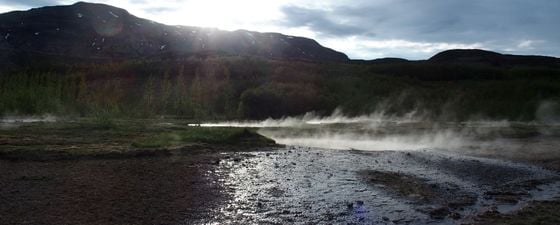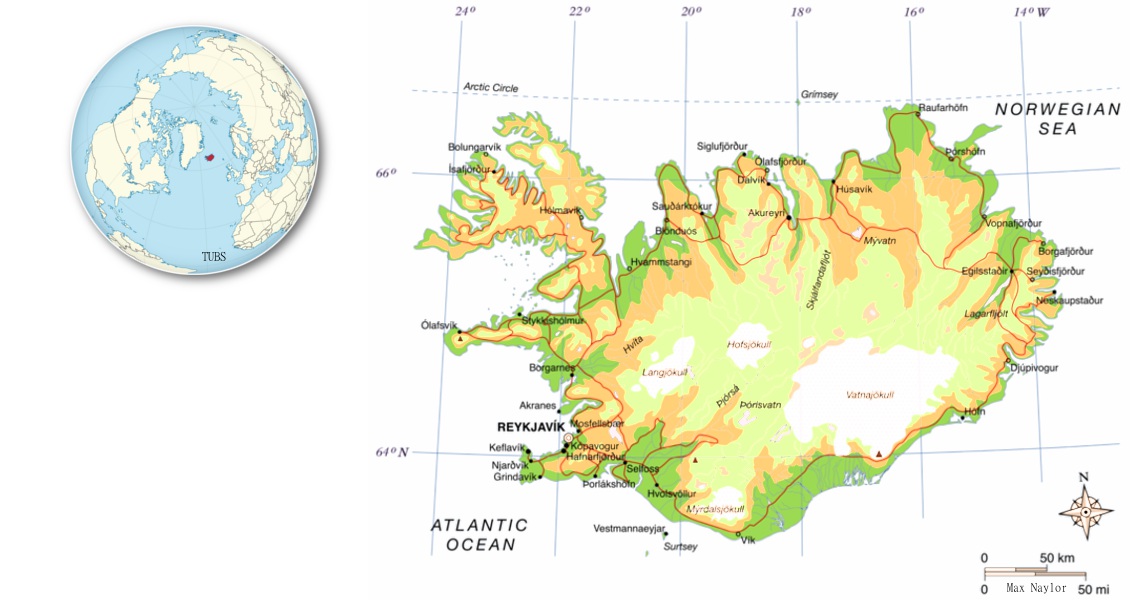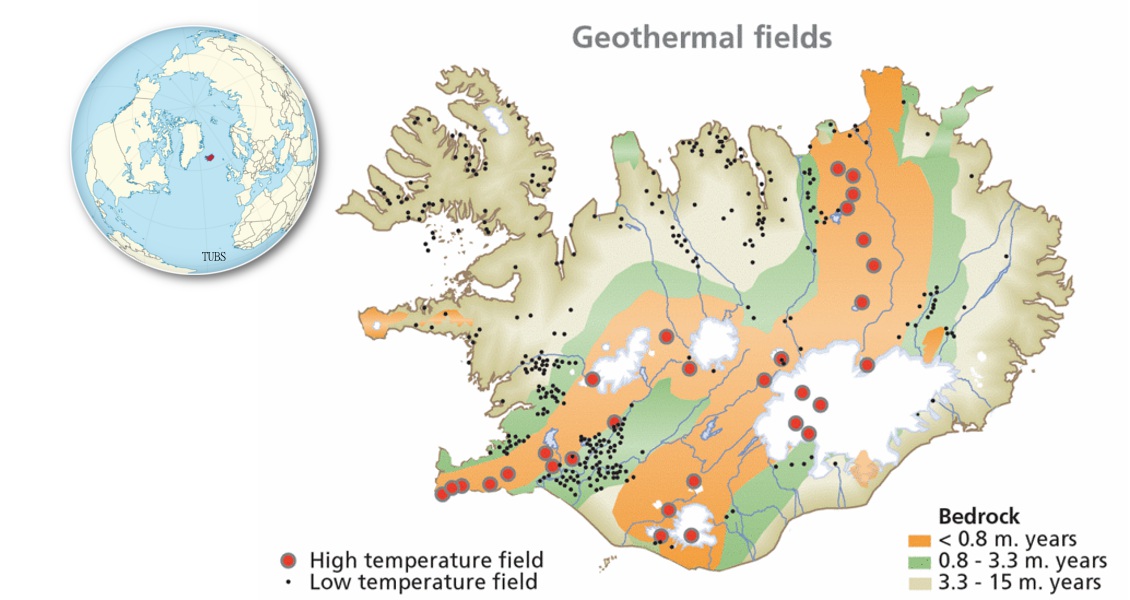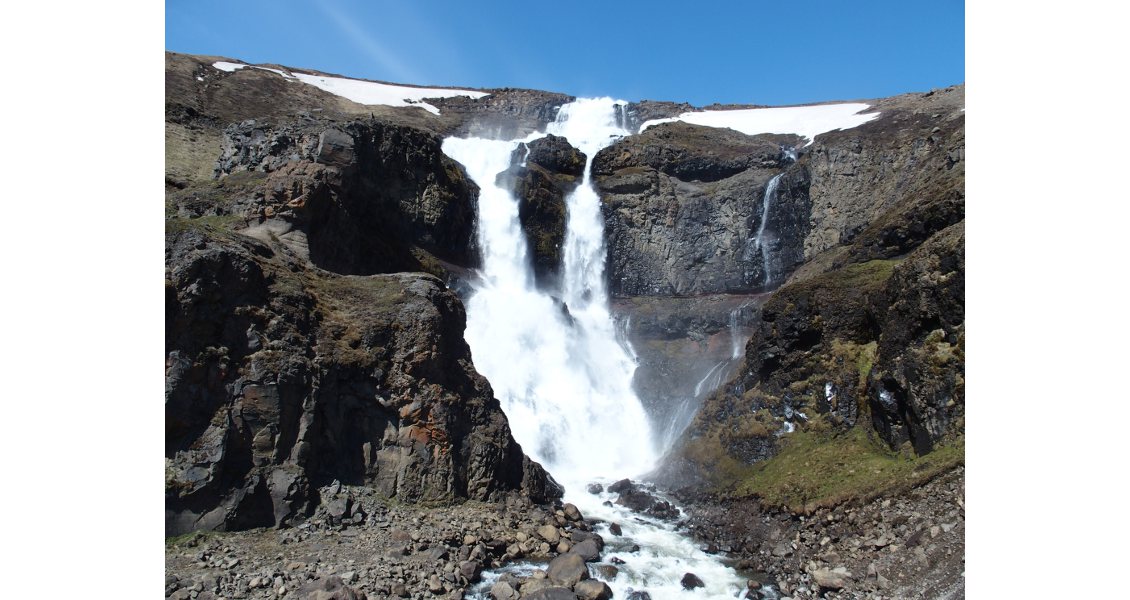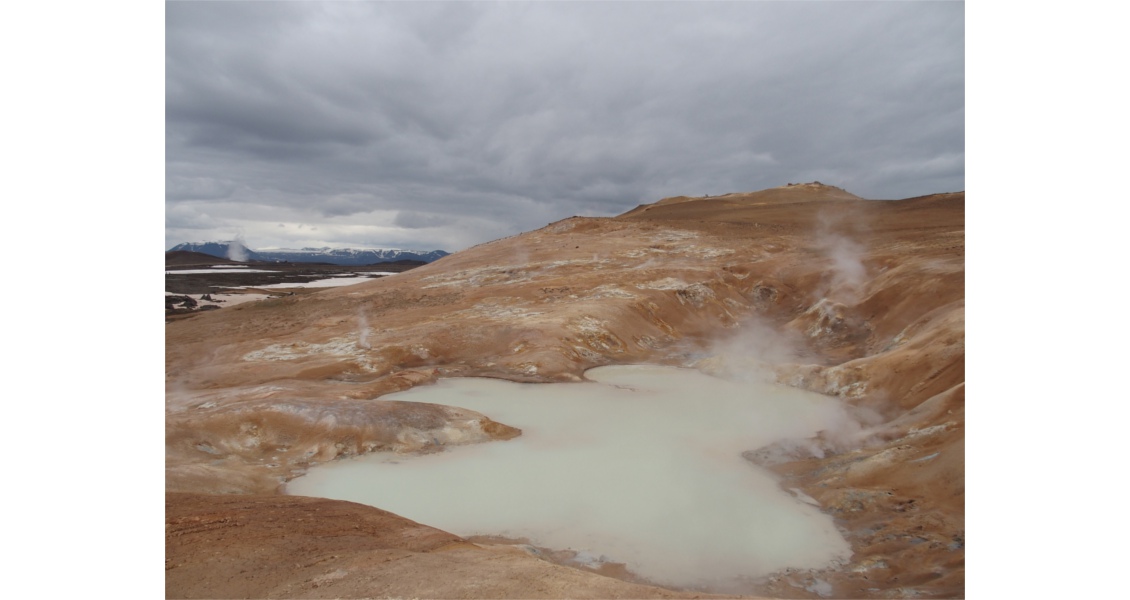Iceland is a country shaped by and reliant on its geology in a remarkable way. Not just because its resultant stunning scenery encourages ever-increasing numbers of foreign visitors – up 20% per year on average since 2010, with tourism responsible for nearly 30% of the country’s export revenue – but because its geology means that the country’s electricity is almost entirely generated from renewable energy sources. The majority comes from hydroelectricity, as the water disgorged from the central highlands and ice fields drops hundreds of metres through spectacular waterfalls, releasing enormous amounts of energy in the process. However, 24% of electricity in Iceland is generated by geothermal energy, and over 90% of buildings in the country now have it as their heat source.
Where Does Geothermal Heat Come From?
The heat in the earth is generated in the mantle and crust by the decay of uranium and thorium. Iceland, one of the most tectonically active places on earth, sits on the Mid-Atlantic Ridge dividing the North American and Eurasian plates, and this is the reason why it can access such large volumes of geothermal energy. It lies above a ‘hot spot’ where the molten deep mantle material wells up from depth and either emerges at the surface in the form of volcanoes or intrudes into the shallow geology, increasing the temperature of the surrounding rock and groundwater, which in turn makes its way to the surface in the form of hot springs and geysers. More than 600 springs with temperatures over 20°C have been located in the country.
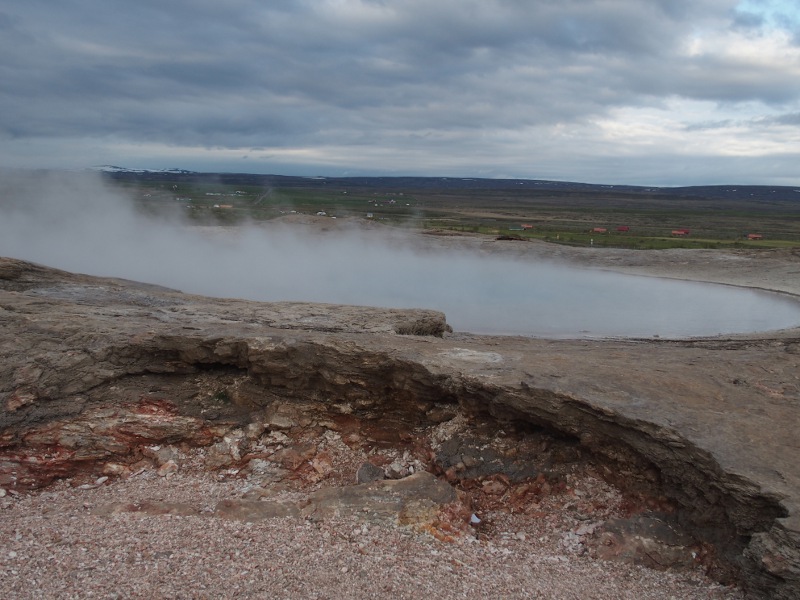 Steam rising from a hot pool at Geysir in south-west Iceland, from which the phenomenon gets its name. Hydrogen sulphide in the steam tends to be oxidised at the surface by atmospheric oxygen, either into elemental sulphur deposited around the vents, or into sulphuric acid, which leads to acid waters altering the soil and bedrock, as can be seen here. (Source: Jane Whaley)Iceland’s abnormally hot crust, warmed by rising magma, is the heat source for the water, but the extensive fracture system, exacerbated by ongoing tectonic activity, provides channels for the water to circulate and distribute the heat.
Steam rising from a hot pool at Geysir in south-west Iceland, from which the phenomenon gets its name. Hydrogen sulphide in the steam tends to be oxidised at the surface by atmospheric oxygen, either into elemental sulphur deposited around the vents, or into sulphuric acid, which leads to acid waters altering the soil and bedrock, as can be seen here. (Source: Jane Whaley)Iceland’s abnormally hot crust, warmed by rising magma, is the heat source for the water, but the extensive fracture system, exacerbated by ongoing tectonic activity, provides channels for the water to circulate and distribute the heat.
As can be seen from the map above, high-temperature zones, where underground water can reach temperatures of 250°C within 1,000m of the surface, are primarily located within the active volcanic zones, mostly on high ground. The bedrock in these areas is less than 0.8 million years old and very permeable and the water table is deep. Under pressure, the water emerges through vents at the surface as steam, which contains high quantities of hydrogen sulphide. The highest recorded downhole temperature for groundwater in Iceland is 386°C.
Groundwater with lower temperatures – between 20 and 150°C – is found in older rocks, usually close to the edges of the main south-west to north-east trending volcanic zone. The groundwater is of meteoric origin, falling on the central highlands and percolating down until it meets the hotter bedrock, when it warms, resulting in a lower density, causing it to rise again, often reaching the surface as hot or boiling springs.
Water from the low-temperature areas is primarily used to heat homes, while that from high-temperature areas, which is too mineralised and gas-rich for domestic use, is used to power turbines and thus generate electricity.
Steaming Bay
Iceland was first settled in the 9th century by Viking explorers, who arrived in the south-west and were so impressed by the visibly steaming thermal springs that they named their town Reykjavik, or ‘Steaming Bay’. Icelanders have always enjoyed bathing in hot natural pools as well as using them to wash their clothes, with stories of bathing in naturally heated water going back to the 13th century.
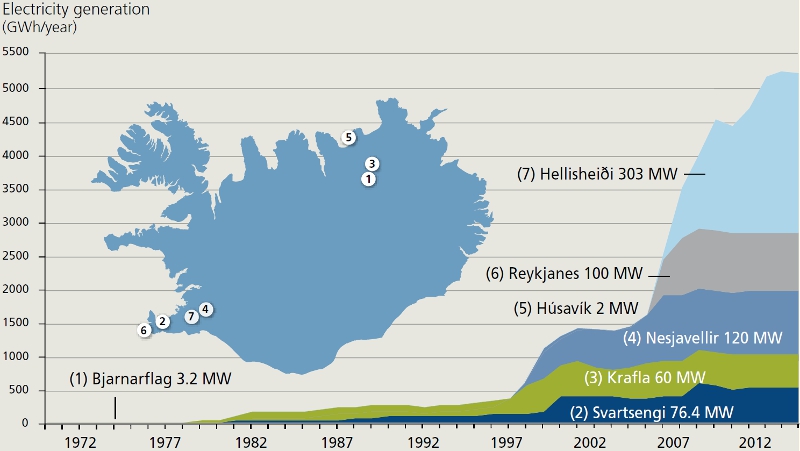 Geothermal power plants in Iceland, showing the capacity of each one. (Source: Orkustofnun)Geothermal water was not used domestically, however, until early in the 20th century, when water from nearby springs was piped into houses and also into greenhouses. These projects were all financed by individuals, but in the early 1930s official drilling into the hot reservoirs began, in the Laugardalur valley, in order to provide hot water and heating to local schools, hospitals, swimming pools and houses in Reykjavik. Initially, technology limited drilling to less than 250m, but the development of the steam rig in 1958 allowed wells to be drilled up to 3,000m, accessing the deeper groundwater reservoirs.
Geothermal power plants in Iceland, showing the capacity of each one. (Source: Orkustofnun)Geothermal water was not used domestically, however, until early in the 20th century, when water from nearby springs was piped into houses and also into greenhouses. These projects were all financed by individuals, but in the early 1930s official drilling into the hot reservoirs began, in the Laugardalur valley, in order to provide hot water and heating to local schools, hospitals, swimming pools and houses in Reykjavik. Initially, technology limited drilling to less than 250m, but the development of the steam rig in 1958 allowed wells to be drilled up to 3,000m, accessing the deeper groundwater reservoirs.
The beginning of the 1970s saw the introduction of steam to generate energy using turbines. The first power stations of this kind were built in the mid-1970s by the Icelandic government at Bjarnarflag and Krafla, in the Lake Mývatn area in north-east Iceland, although development at the latter was hampered by political feuds and technical complications as well as volcanic activity. A year after construction work began an eruption only 3 km away sent corrosive gas into the geothermal system, which destroyed the borehole linings. The tectonic activity did not calm down until 1984.
Svartsengi, the first geothermal power plant on the Reykjanes Peninsula, was started in 1977, and the latest addition to it was constructed in 2008. Water which had been through the turbines and heat exchanger was collected in a mineral-rich man-made pool – now known as ‘The Blue Lagoon’, one of Iceland’s premier tourist attractions, which draws hundreds of thousands of visitors a year.
There are now six geothermal power stations in Iceland, the biggest, and also the third largest on the world, being at Hellisheiði in the Hengill area in south-west Iceland. It was opened in 2006 and now has a capacity of 303 MW of electricity and 400 MW of hot water.
Minimal Environmental Issues
Geothermal energy is considered a ‘clean’ fuel, as it does not burn fossil fuels, and most geothermal plants emit about a sixth of the carbon dioxide of a relatively clean natural-gas-fuelled power plant, while binary plants (see box above) emit none. And, unlike other renewable energy sources such as wind and solar power, it is always available, and it is also very safe. Although the initial outlay, particularly drilling wells, is costly, running a geothermal power plant is relatively inexpensive; savings from direct use are reported to be as much as 80% over fossil fuels.
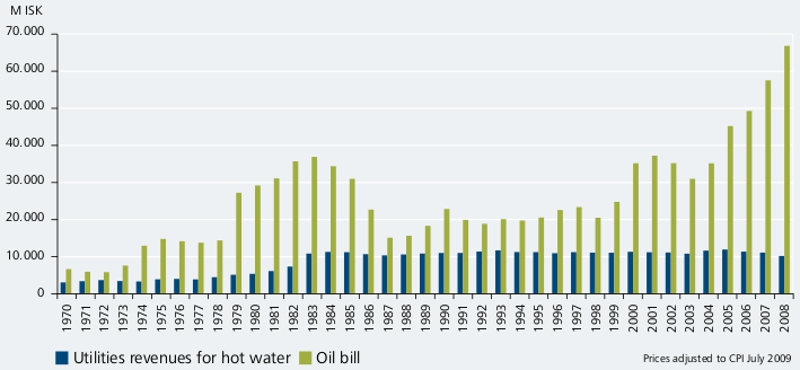 Cost benefits. (Source: Orkustofnun)However, the conversion efficiency of geothermal power developments is generally lower than that of conventional thermal power plants such as coal, natural gas, oil, and nuclear power stations. In addition, exhaust heat is often wasted, unless it can be used locally in greenhouses, timber mills and for district heating.
Cost benefits. (Source: Orkustofnun)However, the conversion efficiency of geothermal power developments is generally lower than that of conventional thermal power plants such as coal, natural gas, oil, and nuclear power stations. In addition, exhaust heat is often wasted, unless it can be used locally in greenhouses, timber mills and for district heating.
Although thought of as a ‘green’ source, geothermal energy does bring with it some environmental issues, particularly the release of hydrogen sulphide with its unpleasant smell, while the waste water may contain toxic elements such as arsenic and mercury, which are harmful if released into rivers or lakes instead of being reinjected.
It is undoubtedly a renewable energy source that can be utilised in a sustainable manner, but the process of extracting geothermal fluids is thought to remove heat from natural reservoirs at over ten times their rate of replenishment, partially balanced by injecting waste fluids back into the system. There is also a danger that natural features such as hot springs, mud pools and geysers can be irreparably damaged by geothermal development. Excessive production from a geothermal field is therefore not sustainable, but in Iceland they use ‘stepwise development’, which takes into consideration the individual conditions of each geothermal system, looking at the production and response history of the reservoir during the first development step to estimate the size of the next development step, thus minimising damage as well as long-term production costs.
Leading the Science
Icelanders have benefited hugely from the fortuitous geological siting of their island, where the energy current beneath it has been estimated to be about 30 GW. The development of geothermal resources has had a notable impact on social life; better space heating improves both comfort and health, while snow-melting in private and public spaces and sports arenas has increased safety and allowed people to enjoy outdoor sports in winter. Beautiful geothermal swimming pools have developed into social meeting places for all generations, while the type and variety of foods available in the country have improved through the heating of greenhouses.
Iceland is now one of the leading countries in geothermal science and technology, with a well-recognised community of scientists, engineers and academics whose advice is often sought by countries looking to develop their own resources. Cutting-edge research includes the Iceland Deep Drilling Project, a long-term study of high-temperature hydrothermal systems in Iceland.
The earth is a huge heat engine, and after 4.5 billion years we have about 85% remaining, so Icelanders should be able to keep themselves warm for some time yet!

